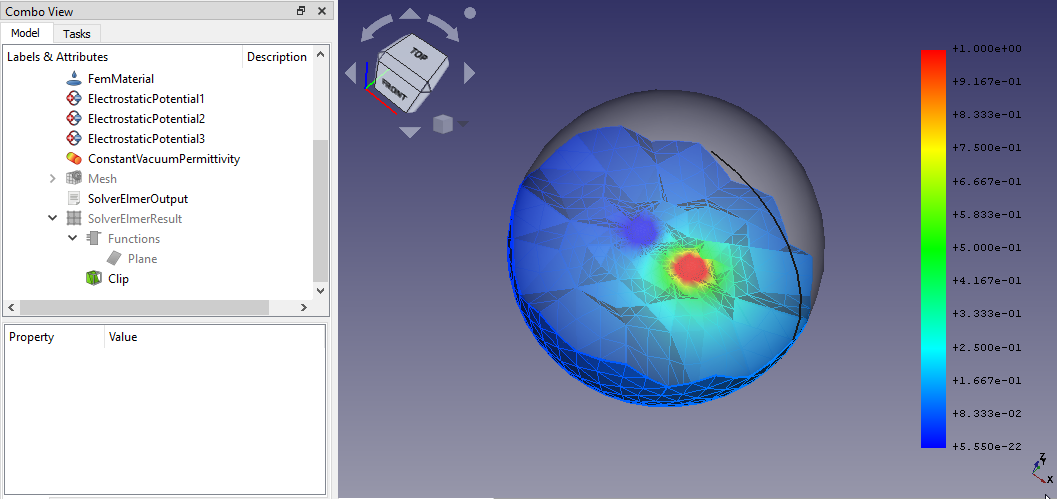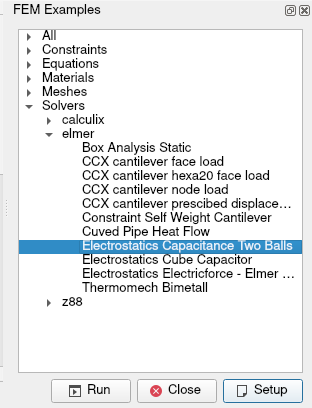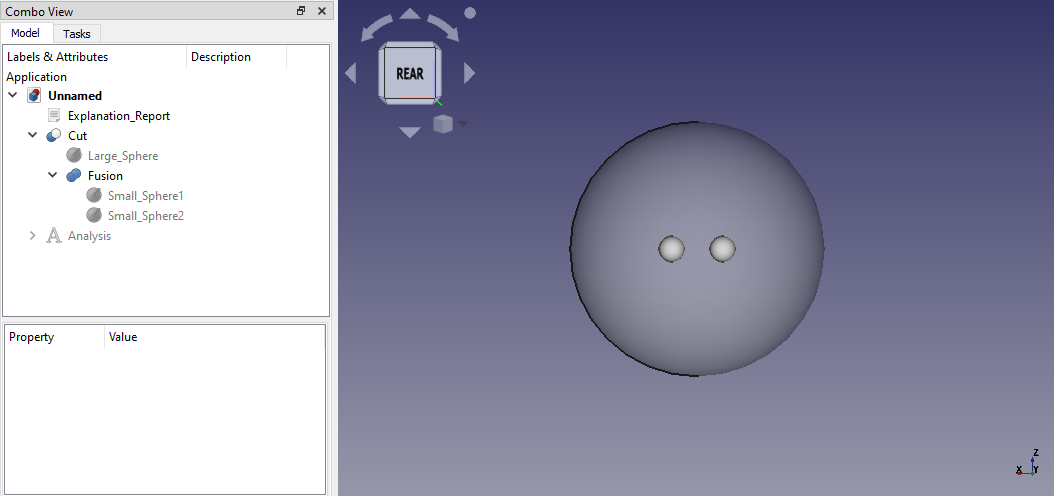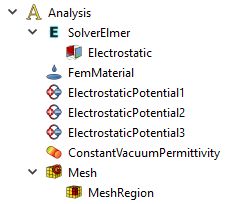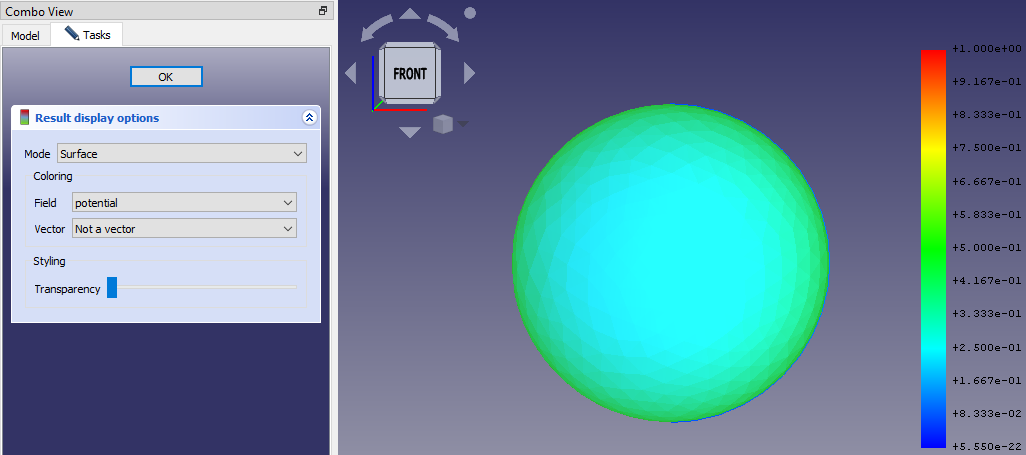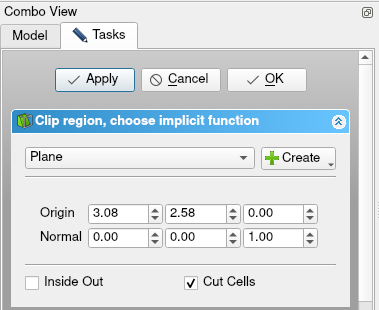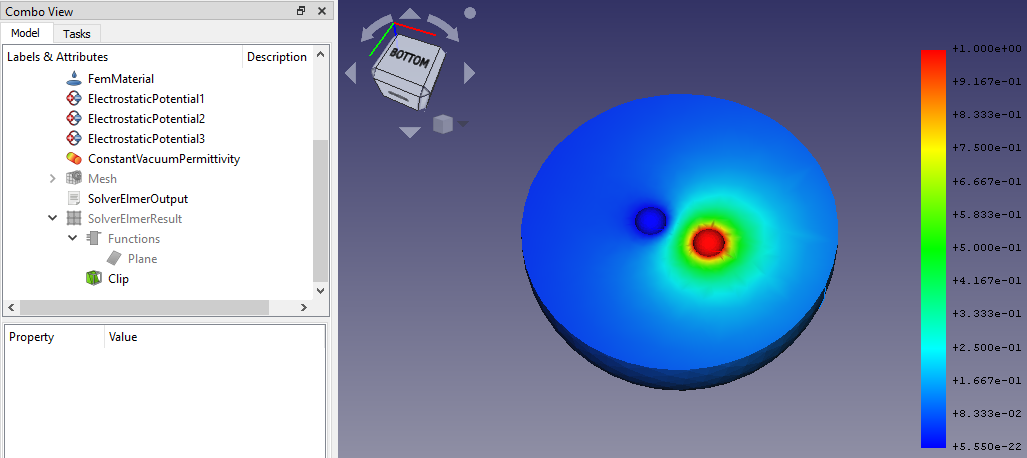FEM Example Capacitance Two Balls/de
| Thema |
|---|
| Finite Elemente Analyse |
| Niveau |
| Anfänger |
| Bearbeitungszeit |
| 30 min |
| Autoren |
| Sudhanshu Dubey |
| FreeCAD-Version |
| 0.19 oder höher |
| Beispieldateien |
| Programmgesteuert erstellt |
| Siehe auch |
| None |
Einleitung
Dieses Beispiel soll zeigen, wie das 6. Beispiel der Elmer-GUI-Tutorials, Electrostatic equation – Capacitance of two balls, unter Verwendung der neuen FEM Beispiele simuliert wird. Es zeigt, wie das Beispiel aufgebaut wird, beschreibt verschiedene Bestandteile, zeigt die Berechnung mit Elmer und wie die Ergebnisse mit Ausschnittfiltern dargestellt werden.
Das Endergebnis dieses Tutorium
Voraussetzungen
- A compatible version of FreeCAD designated in the tutorial overview.
- Use the Help → About FreeCAD to see the version of FreeCAD installed
- No external software is needed for loading the example, viewing the mesh and geometry as well as for visualizing the results.
- For solving the finite element analysis (FEA), the solver software Elmer must be installed on your computer. See this page for how to install Elmer.
Das Beispiel vorbereiten
Arbeitsbereich FEM laden
- FreeCAD starten, Der Arbeitsbereich Start sollte geladen werden.
- Zum Arbeitsbereich
FEM wechseln.
Das Beispiel laden
Den Simulationsfall verstehen
Dieser Fall stellt die Lösung der Kapazität von perfekt leitenden Kugeln im freien Raum dar. Eine Spannungsdifferenz zwischen den Kugeln führt dazu, dass elektrische Ladung in das System eingebracht wird. Die Kugeln haben auch eine Eigenkapazität, die aus der Spannungsdifferenz mit dem Fernfeld resultiert. Daher muss eine symmetrische Kapazitätsmatrix der Größe 2 × 2 gelöst werden. Die Kapazitäten können aus zwei verschiedenen Spannungskonfigurationen berechnet werden.
Das Modell verstehen
- Das Modell enthält drei Kugeln.
- Die beiden kleineren sind perfekt leitende Kugeln.
- Die größere Kugel simuliert die Umgebungsluft.
- Die beiden kleineren Kugeln werden miteinander verschmolzen und diese Verschmelzung wird dann von der größeren Kugel abgeschnitten.
Das Ausgangsmodell
Der Analyse-Container und seine Objekte
The objects used in this electrostatic analysis:
Analysis container
SolverElmer
Electrostatic, the electrostatics equation
FemMaterial, a fluid material to represent the surrounding air
ElectrostaticPotential, constraints (3 of them)
ConstantVaccumPermittivity, optional
Mesh, a Gmsh mesh
MeshRegion, a mesh region for the smaller spheres
Die Objekte, wie sie in der Baumansicht dargestellt werden
Die FEA durchführen
- In der Baumansicht auf das Löser-Objekt
doppelklicken.
- Im gleichen Aufgaben-Fenster auf die Schaltfläche Schreiben klicken. Man beobachte das Protokollfenster, bis "write completed" angezeigt wird. Die möglicherweise angezeigte Warnung zur Vakuumpermittivität kann ignoriert werden.
- Auf die Schaltfläche Ausführen drücken. Da es sich um eine kleine Analyse handelt, sollte die Ausführung nur wenige Sekunden dauern. Bitte warten, bis Folgendes in der Ausgabe zu sehen ist: "ELMER SOLVER FINISHED AT".
- Auf die Schaltfläche Schliessen im Aufgaben-Fenster drücken, nachdem der Durchlauf beendet ist.
- In der Baumansicht sollten zwei neue Ergebnisobjekte erstellt werden,
SolverElmerResult und
SolverElmerOutput.
Wenn man beim Auslösen der Analyse eine Fehlermeldung zu Solver-Binärdateien oder Ähnlichem erhält, Folgendes überprüfen: Die Installation von Elmer.
Ergebnisse darstellen
- Make sure the mesh is invisible. If not, select the
Mesh object and press Space to toggle the visibility.
- Also make sure the Cut object is invisible.
- Double click on the
SolverElmerResult object to open its task dialog.
- Change the "Field" to "potential" and press OK.
- You will notice that the color of the sphere has changed to blue and that the gradient on the right is showing values from 0 to 1. It should look something like this:
Die Ergebnisse nachbearbeiten
- While we have successfully visualised the potential result, currently we are only seeing the zero potential in the air surrounding the two balls. To view the potential on the balls we need to apply a clip filter.
- In the Tree View select the
SolverElmerResult object and then from the tool bar click on the button
Region Clip Filter.
- This will open a dialog with the filter configurations. Click there on the button
Create and choose
Plane. This adds a plane through the center of the sphere at which the result mesh is cut. To smooth the cut face, check the option Cut Cells. Eventually click Apply.
- In der Baumansicht gibt es einen neuen Eintrag namens Funktionen. Er enthält die erstellte
Ebene. Mit der Leertaste unsichtbar machen.
- Doppel-Klick auf das
Zuschnitt-Objekt in der Baumansicht.
- Das "Feld" auf "Potential" ändern und OK drücken.
- Die Sichtbarkeit des
SolverElmerResult-Objekts mittels der Leertaste umschalten und man sieht etwa Folgendes:
Jetzt können wir diese potenzielle Verteilung in und um die Kugeln herum deutlich erkennen.
Beachte, dass wenn Änderungen anwenden aktiviert ist, das „Feld“ direkt im Zuschneiden-Dialogfeld ausgewählt werden konnte und somit hätte es nach der Erstellung der Ebene nicht erneut geöffnet werden müssen.
Die Kapazität ermitteln
- Unser eigentlicher Fokus liegt darauf, die Kapazität zu ermitteln, die in der
SolverElmerOutput enthalten sind.
- Doppelt auf
SolverElmerOutput klicken, um es zu öffnen. Nach unten scrollen, bis Folgendes zu finden ist:
StatElecSolve: Capacitance matrix computation performed (i,j,C_ij) StatElecSolve: 1 1 5.07016E+00 StatElecSolve: 1 2 1.69328E+00 StatElecSolve: 2 2 5.07201E+00
- Here, our desired result is
C12 = 1.69328. This value is close to the1.691given in the Elmer GUI Tutorials. We can get an even closer value by making a finer Mesh Region but this activity is left for the user. Also, the user is advised to play with the Clip Filter to get a visual result similar to the first picture of this tutorial.
- Materials: Solid Material, Fluid Material, Non-Linear Mechanical Material, Reinforced Material (Concrete); Material Editor
- Element Geometry: Beam Cross Section, Beam Rotation, Shell Plate Thickness, Fluid Section for 1D Flow
- Electromagnetic Boundary Conditions: Electrostatic Potential Boundary Condition, Current Density Boundary Condition, Magnetization Boundary Condition, Electric Charge Density
- Fluid Boundary Conditions: Initial Flow Velocity Condition, Initial Pressure Condition, Flow Velocity Boundary Condition
- Geometrical Analysis Features: Plane Multi-Point Constraint, Section Print Feature, Local Coordinate System
- Mechanical Boundary Conditions and Loads: Fixed Boundary Condition, Rigid Body Constraint, Displacement Boundary Condition, Contact Constraint, Tie Constraint, Spring Boundary Condition, Force Load, Pressure Load, Centrifugal Load, Gravity Load
- Thermal Boundary Conditions and Loads: Initial Temperature, Heat Flux Load, Temperature Boundary Condition, Body Heat Source
- Overwrite Constants: Constant Vacuum Permittivity
- Mesh: Mesh From Shape by Netgen, Mesh From Shape by Gmsh, Mesh Boundary Layer, Mesh Refinement, Mesh Group, Erase Elements, FEM Mesh to Mesh
- Solve: Solver CalculiX, Solver Elmer, Solver Mystran, Solver Z88; Mechanical Equations: Elasticity Equation, Deformation Equation; Electromagnetic Equations: Electrostatic Equation, Electricforce Equation, Magnetodynamic Equation, Magnetodynamic 2D Equation, Static Current Equation; Flow Equation, Flux Equation, Heat Equation, Solver Job Control, Run Solver
- Results: Purge Results, Show Result, Apply Changes to Pipeline, Post Pipeline From Result, Pipeline Branch, Warp Filter, Scalar Clip Filter, Function Cut Filter, Region Clip Filter, Contours Filter, Glyph Filter, Line Clip Filter, Stress Linearization Plot, Data at Point Clip Filter, Calculator Filter; Filter Functions: Plane, Sphere, Cylinder, Box; Data Visualizations: Create Lineplot, Create Histogram, Create Table
- Utilities: Clipping Plane on Face, Remove All Clipping Planes, FEM Examples; Clear FEM Mesh, Display Mesh Info
- Additional: Preferences; FEM Install, FEM Mesh, FEM Solver, FEM CalculiX, FEM Concrete; FEM Element Types
- Erste Schritte
- Installation: Herunterladen, Windows, Linux, Mac, Zusätzliche Komponenten, Docker, AppImage, Ubuntu Snap
- Grundlagen: Über FreeCAD, Graphische Oberfläche, Mausbedienung, Auswahlmethoden, Objektname, Voreinstellungseditor, Arbeitsbereiche, Dokumentstruktur, Objekteigenschaften, FreeCAD unterstützen, Spenden
- Hilfe: Anleitungen, Videoanleitungen
- Arbeitsbereiche: Std Base, Arch, Assembly, BIM, CAM, Draft, FEM, Inspection, Material, Mesh, OpenSCAD, Part, PartDesign, Points, Reverse Engineering, Robot, Sketcher, Spreadsheet, Surface, TechDraw, Test Framework
